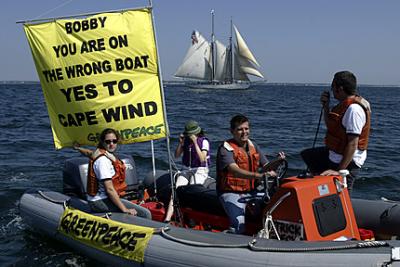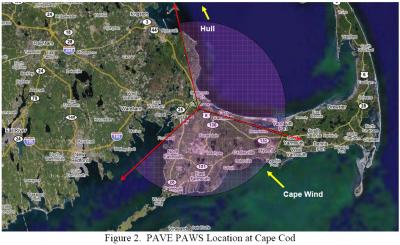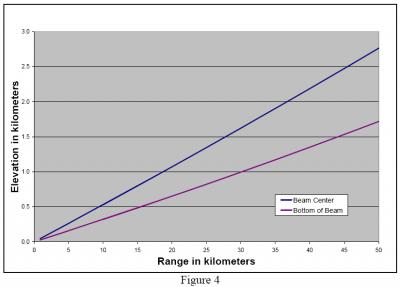First the Coast Guard said it, now the DOD is saying it. Cape wind WILL NOT interfere with radar. It can’t get much clearer than that. However like any good Astroturf organization the truth has very little to do with what the opposition to the project’s spokesman say.
First a bit of a run down of the news. The DOD has released a statement that the radar installations on Cape Cod (radar installations that I might add have been accused of causing cancer, and have been VERY unpopular for years) need about 15.5 miles of buffer zone, of which the proposed wind farm is 1.4 miles outside of. A nice big buffer.
“It’s really not considered a problem,†said Rick Lehner, the spokesman for the Missile Defense Agency. He did say that wind turbines would have an effect on radar, but that Cape Wind would not effect any radar stations because of its distance from them. It’s important to point out that this report also mentions that PAVE PAWS is not yet part of the military’s proposed missile defense shield, you know the one lots of people think won’t work and the one that is pissing off Russia.
I think in this day and age of knee jerk patriotism, where politicians relate everything they can back to 9/11 or terrorism in some way this issue is smoke screen build on lies supported by bull shit. First most thinking people realize that if Russia and the USA started lobbing missiles at each other, it really wouldn’t matter, the world would be over. Secondly what is more important, clean renewable energy or more military spending, look at the mess we are in now (I would even argue that building wind farms could help lower the instances of war for oil). Thirdly, the military itself says that the proposed project will not interfere with their massive waste of money missile defense shield.
So its settled two branches of the military have said there is no problem we can go get our hammers and start putting in some turbines…well not according to some. The mark of any good phony organization is a complete divorcing of itself from the real world, and any truth or facts that may pertain to what you are lobbying for. For a couple good examples see the smoking industry, the poison chemical industry, big oil, and the Alliance to protect Nantucket sound. Here is what they had to say.
The report issued today by the U.S. Department of Defense (DOD) confirms the very real risks to our national security posed by wind turbines interfering with missile defense systems, the Alliance to Protect Nantucket Sound said in a statement released today.
The DOD report states “Utility class wind farms could have significant impacts on radars, including the missile defense early warning radars.†PAVE PAWS at Cape Cod Air Force Base and Beale Air Force Base are the only two such early warning defense systems in the continental US. Early warning radars like PAVE PAWS, near the site selected by Cape Wind for their proposed complex of 130 turbines, are necessary to detect and track threatening objects like Inter-Continental Ballistic Missiles and objects in space, and are critical to national security.
Translation, “AHHHHHHH RUNNNNN!!!!!!” If you build Cape Wind, the Russians will get us! It’s hard to argue with that iron clad demonstration of logic, but the Missile Defense Agency (you know the people who released the report) gives it their best shot.
From the report (PDF)
CONCLUSIONS AND RECOMMENDATIONS
- Utility class wind farms could have a significant impact on radars, including the missile defense early warning radars (EWRs), the PAVE PAWS radar at Cape Cod AFS, MA, and the Upgraded Early Warning Radar (UEWR) at Beale AFB, CA.
- To mitigate this impact, establish and enforce a wind farm offset zone within the effective “line-of-sight†of the radars, taking into account the direct, refracted, and diffracted signals from the radar. This effectively establishes a zone around the radar of approximately twenty-five kilometers, assuming relatively level terrain.
- Within twenty-five kilometers, further study would be required to assess the impact accounting for location within the radar’s field of view and the relative height of the wind turbine and the radar’s main beam.
- After establishing this offset zone, eliminate any remaining impacts on the radar by using gain control and range gating techniques.
(this part seems to indicate that they would be able to have wind farms closer than the buffer if they simply adjusted their equipment for the interference, taking even more force out of the opponents arguments)
What they are saying is that big huge metal towers will in fact affect the radar beam, IF (perhaps it was because this word has only two letters that some people missed it) the big huge metal towers are close enough to the radar. Lets see a diagram, again helpfully supplied by the MDA.
As you can see at the suggested 25 kilometer range the beams of the radar are more than a half a kilometer in the air, half a kilometer is about 1640 feet high, these wind turbines will be 440 feet tall, leaving over a thousand feet of buffer for their precious radar to operate with no problem.
The principle impact of wind turbines in the radar sidelobes are the reflected returns. If not mitigated, these could provide false targets to the radars. Since the EWRs are designed to search and track at long ranges (beyond 1000 km), only a small portion of the transmitted energy could be received from objects reflecting energy at ranges less than 100 km, where sidelobe energy may reach wind turbines. At these short ranges, the impact of the energy return from targets is mitigated by pulse eclipsing and range gating, which prevents the radar from receiving the full transmitted pulse energy. In addition, data processing techniques for automatic gain control can mitigate returns from targets close in range, as is performed on the energy reflected
from the Sutter Buttes west of Beale AFB.
Clearly the technology is here to offset any problems that would arise if the project was inside the buffer zone (which it IS NOT). I am not a big fan of the military, but I am willing to trust them when they say their own equipment will not be harmed or in any way interfered with by the proposed Cape Wind project.


